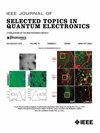Enhancing External Cavity Laser Diode Performance Through Optimized Fano Spectrum Feedback Configuration
IF 5.1
2区 工程技术
Q1 ENGINEERING, ELECTRICAL & ELECTRONIC
IEEE Journal of Selected Topics in Quantum Electronics
Pub Date : 2025-01-30
DOI:10.1109/JSTQE.2025.3536449
引用次数: 0
Abstract
Laser diodes with narrow linewidth are essential for optical communication, spectral analysis, and precision measurement. This study reinterprets the linewidth narrowing mechanism in external-cavity diode lasers (ECDLs) from a perspective that the noise-induced frequency fluctuations are suppressed by the rapidly varying phase in frequency domain introduced by the external cavity. We highlight the importance of the localized high slope in the rising edge of the feedback spectrum in forming stable narrow linewidth laser modes. Based upon this understanding, we introduce an alternative to traditional Lorentzian optical feedback. We demonstrated that asymmetric lineshapes, such as Fano, can serve as the optical feedback of ECDLs with enhanced performance. Theoretical analysis and numerical simulations reveal that Fano-based external cavity lasers, benefiting from a feedback spectrum with a steeper local slope than Lorentz-based cavities, can achieve superior linewidth narrowing under the same fabrication conditions. This study offers a novel approach for the design and application of narrow linewidth laser diodes.通过优化Fano光谱反馈配置增强外腔激光二极管性能
窄线宽的激光二极管在光通信、光谱分析和精密测量中是必不可少的。本研究从外腔引入的频域快速相位抑制噪声引起的频率波动的角度重新解释了外腔二极管激光器(ecdl)的线宽变窄机制。我们强调了反馈光谱上升沿的局部高斜率对于形成稳定的窄线宽激光模式的重要性。基于这种理解,我们引入了一种替代传统洛伦兹光反馈的方法。我们证明了非对称线形,如Fano,可以作为ecdl的光学反馈,并增强了性能。理论分析和数值模拟表明,在相同的制造条件下,基于fanz的外腔激光器具有比基于lorentz的腔更陡的局部斜率的反馈谱,可以实现更好的线宽窄化。该研究为窄线宽激光二极管的设计和应用提供了一条新的途径。
本文章由计算机程序翻译,如有差异,请以英文原文为准。
求助全文
约1分钟内获得全文
求助全文
来源期刊

IEEE Journal of Selected Topics in Quantum Electronics
工程技术-工程:电子与电气
CiteScore
10.60
自引率
2.00%
发文量
212
审稿时长
3 months
期刊介绍:
Papers published in the IEEE Journal of Selected Topics in Quantum Electronics fall within the broad field of science and technology of quantum electronics of a device, subsystem, or system-oriented nature. Each issue is devoted to a specific topic within this broad spectrum. Announcements of the topical areas planned for future issues, along with deadlines for receipt of manuscripts, are published in this Journal and in the IEEE Journal of Quantum Electronics. Generally, the scope of manuscripts appropriate to this Journal is the same as that for the IEEE Journal of Quantum Electronics. Manuscripts are published that report original theoretical and/or experimental research results that advance the scientific and technological base of quantum electronics devices, systems, or applications. The Journal is dedicated toward publishing research results that advance the state of the art or add to the understanding of the generation, amplification, modulation, detection, waveguiding, or propagation characteristics of coherent electromagnetic radiation having sub-millimeter and shorter wavelengths. In order to be suitable for publication in this Journal, the content of manuscripts concerned with subject-related research must have a potential impact on advancing the technological base of quantum electronic devices, systems, and/or applications. Potential authors of subject-related research have the responsibility of pointing out this potential impact. System-oriented manuscripts must be concerned with systems that perform a function previously unavailable or that outperform previously established systems that did not use quantum electronic components or concepts. Tutorial and review papers are by invitation only.
 求助内容:
求助内容: 应助结果提醒方式:
应助结果提醒方式:


